Staff Augmentation vs Project Outsourcing: Making the Right Choice

Two Paths to Growing Your Business
You don't have to hire full-time employees every time you need to improve productivity. Many companies bring in outside talent through staff augmentation, or they hand off entire projects with outsourcing. Both options offer flexibility, access to skilled professionals, and cost savings. They can help businesses grow, streamline operations, and tackle bigger projects. But while they serve a similar purpose, they work in very different ways.
How to decide which one is better for your business? That depends on your project requirements, team structure, and the work you need to complete. In this article, we'll explore staff augmentation vs project outsourcing, how they work, and which approach best fits your needs.
What Is Staff Augmentation?
Staff augmentation is a flexible hiring strategy that allows businesses to bring in external professionals. Instead of hiring full-time employees, companies supplement their inhouse team with skilled experts who integrate into existing workflows. //: IT staff augmentation services provide a seamless way to scale teams with specialized talent, ensuring businesses can meet project demands.
Staff augmentation is especially popular in industries like software development and mobile app development, where projects often require niche expertise. With team augmentation, you get full control over the process while leveraging external talent to keep projects moving efficiently.
Core Principles of Staff Augmentation
Understanding how staff augmentation supplements your existing team can help you realize the most benefit from it. Staff augmentation provides:
🟧 Contract-based hiring that strengthens your existing team.
🟧 A quick and efficient solution when a specific tech stack or skill set is needed.
🟧 Augmented staff working under your management and following your internal processes.
🟧 Service providers that handle sourcing and contracts, freeing you from the hassle of traditional recruitment.
🟧 Access to a global talent pool, including top-tier professionals beyond local hiring limitations, ensuring the right fit for your needs.
How Staff Augmentation Works in Practice
Let’s imagine a tech company that is building a new mobile app. The core team is solid, but they need an experienced mobile UI/UX designer for the next phase. Instead of hiring full-time, they bring in a contract-based designer through //: IT staff augmentation services. The designer integrates into the team, joins internal meetings, follows company workflows, and collaborates directly with developers.
Now, you might wonder: “What is the difference between this style of staff augmentation vs IT outsourcing?” While the two services are similar, there are key differences.
In outsourcing, the company would hand the entire design process off to an external agency or team, and expect a finished product by agreed deadline. With staff augmentation, the company retains full control of the project, and treats the designer as part of the inhouse team. The designer works alongside full-time employees, aligning with the company's goals and processes.
This model applies to developers, QA engineers, data analysts, and other IT specialists. Companies can scale their teams up or down based on project needs, ensuring they always have the specialized skills at the right time.
Benefits of Staff Augmentation for Software Development
For software development teams, staff augmentation provides flexibility without disrupting internal workflows. This makes it a popular choice for businesses that value agility and collaboration. Compared to direct hiring or outsourcing, staff augmentation provides:
> Quick access to top talent: Skip the lengthy hiring process and onboard experts fast.
> Scalability: Expand or shrink your team as the project demands change.
> Cost efficiency: Pay for skills when you need them.
> Seamless integration: Augmented staff works as part of your team, following your workflows and culture.
> Full control: Manage projects directly without outsourcing tasks to a third party.
> Enter new markets: Quickly onboard local talent to navigate new markets without the complexities of setting up a full inhouse team.
Scenarios in Which Staff Augmentation Is the Genius Solution
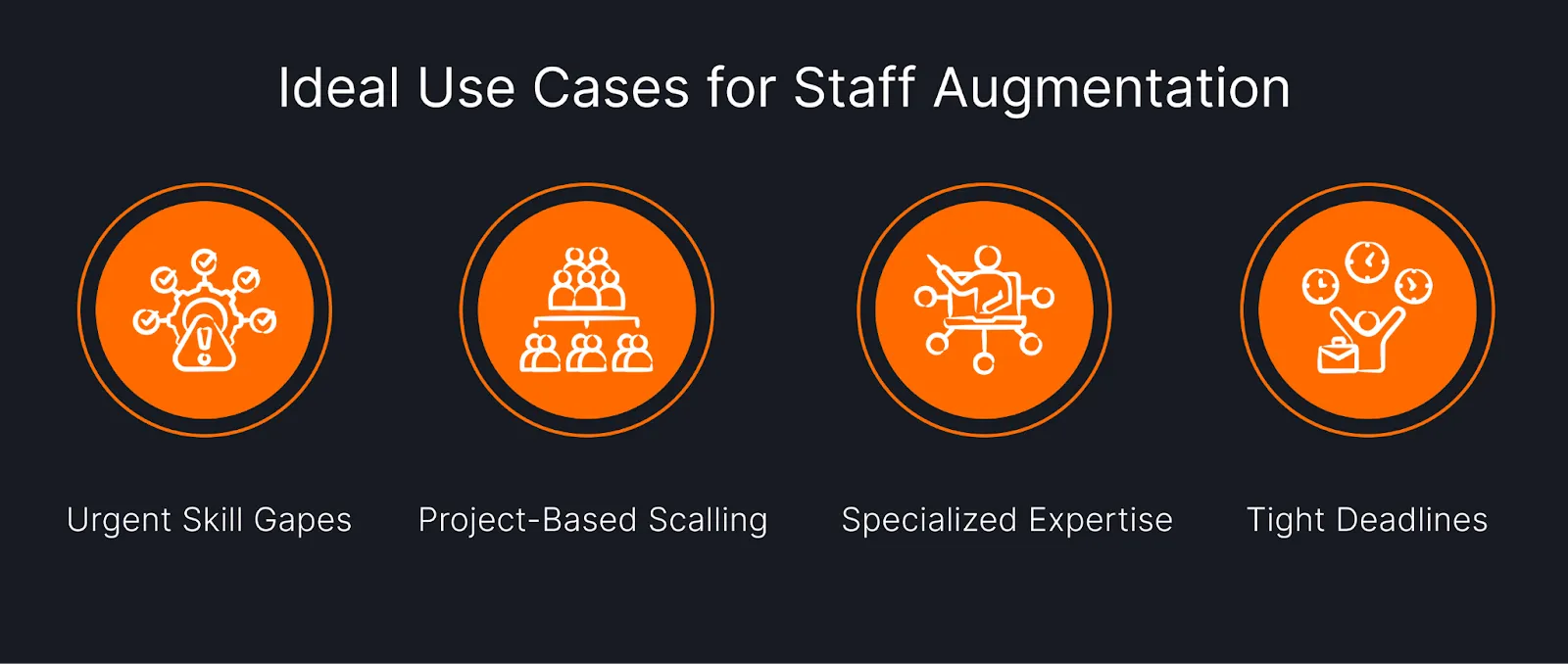
Staff augmentation is the genius solution for many IT projects, helping with:
Urgent skill gaps
Need a DevOps engineer for a fast migration project? Staff augmentation is a great fit.
Project-based scaling
If a product launch requires extra backend developers, you can immediately expand your team.
Specialized expertise
When your inhouse knowledge isn’t enough and you need to fill the gap fast, augmentation services give you fast access to needed skills.
Tight deadlines
Bringing in more hands can help you finish projects in time without overloading your current team.
What Is Outsourcing?
Outsourcing is a business strategy in which companies delegate specific tasks, services, or entire projects to external vendors or specialized teams. It is widely used for software development, app development, technical support, and maintenance.
Instead of handling everything inhouse, businesses that outsource projects need to collaborate with external experts who take full responsibility for delivering results, including team management, project execution, and quality assurance.
Key Concepts of Outsourcing
While companies that outsource cede full control of a project to their collaborators, outsourcing brings many benefits to a project, including:
🟧 Task delegation: Companies hand over specific tasks or projects to external service providers.
🟧 Full-service approach: Vendors take ownership of the work, from planning to execution.
🟧 Cost and resource efficiency: Businesses save time and money by leveraging external expertise.
🟧 Focus on non-core business operations: Allows companies to offload secondary or repetitive tasks, enabling internal teams to concentrate on strategic initiatives.
🟧 Global talent access: Businesses can work with professionals from different regions to find the best expertise.
Types of IT Outsourcing Models: Onshore, Nearshore, and Offshore
Companies can choose different outsourcing models based on their needs, budget, and preferred working style.
> Onshore outsourcing: Working with vendors within the same country. This ensures easier communication and compliance with local regulations.
> Nearshore outsourcing: Partnering with teams in neighboring countries. This often balances cost savings with time zone alignment for smooth collaboration.
> Offshore outsourcing: Hiring teams from distant locations, usually to reduce costs while accessing a broader talent pool. Many companies offshore development to regions known for strong IT expertise.
Advantages of Outsourcing for Software Development Projects
Unlike staff augmentation, in which businesses integrate new hires into their team and oversee their work, outsourcing is useful for businesses with limited management capacity. This means companies don’t have to worry about daily check-ins, task assignments, or performance tracking – the outsourced vendor takes care of it all.
Businesses may face legal, regulatory, and operational challenges when hiring globally. Outsourcing can help businesses navigate these complexities by leveraging local expertise and having the local third party serve as an employer of record (EoR). But companies that outsource in this way lose key control over their projects.
Typical Use Cases for Outsourcing in IT
Since companies delegate significant control over outsourced projects, outsourcing is best suited for short-term initiatives or non-mission-critical projects. It is commonly used in:
End-to-end software development for secondary projects
Companies outsource entire projects, from design to deployment, for products and services that aren’t central to their business.
Technical support & maintenance
Dedicated teams handle ongoing support, updates, and troubleshooting.
Cloud computing & infrastructure management
Businesses rely on external teams to manage servers, databases, and security.
Staff Augmentation vs Outsourcing: Key Differences Explained
Both staff augmentation and outsourcing can help companies grow. Let’s explore how each model fits different business needs.
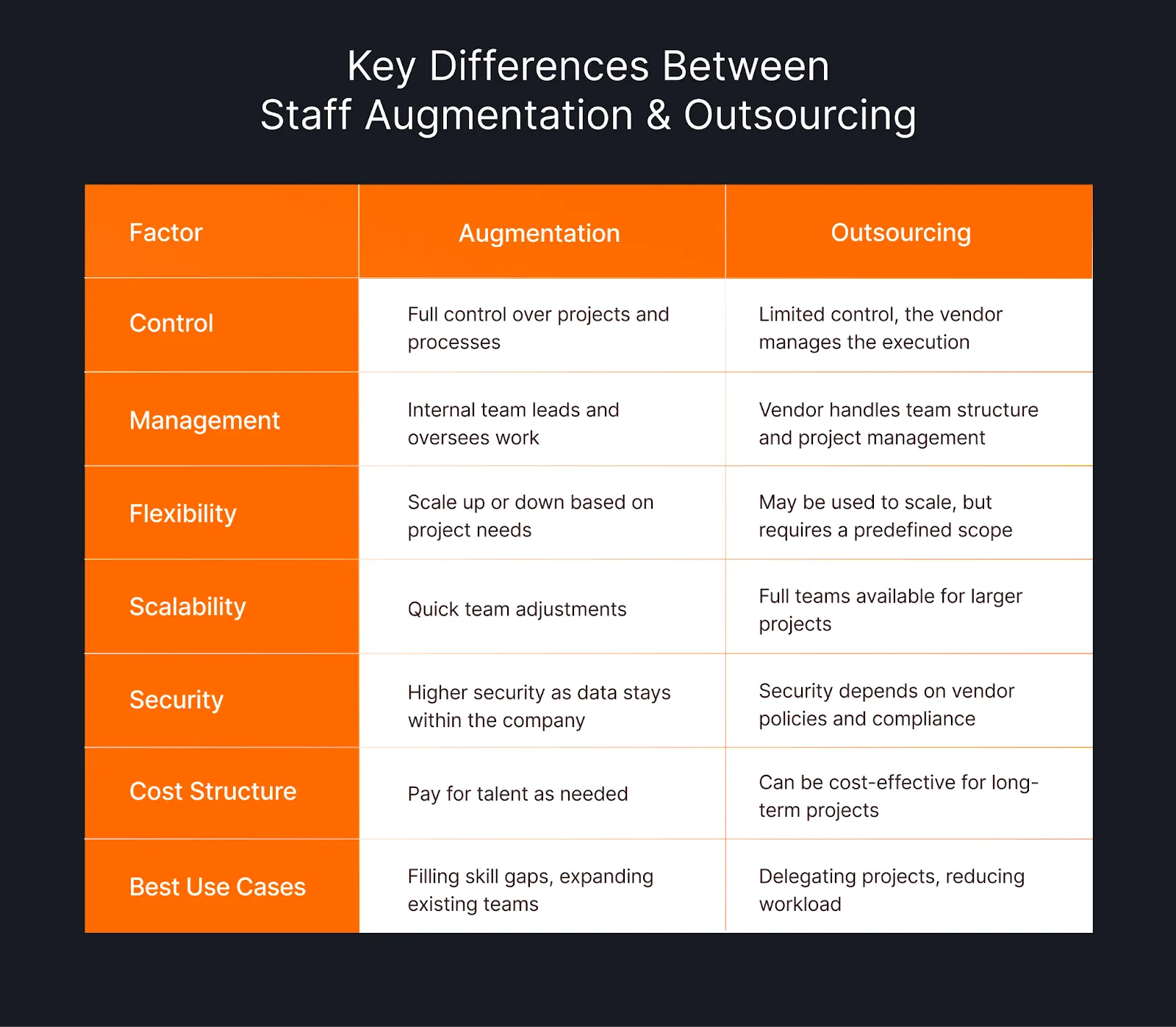
Team Structure and Management Control
When comparing staff augmentation vs software outsourcing, one important difference is control. With team augmentation, companies retain full control over their projects and workflows, which helps to keep security tight, making businesses and their clients more confident in the entire process. Outsourcing, on the other hand, shifts responsibility to an external provider. The choice between these two models depends on the management's capabilities, the project’s scope, and comparative costs, among other factors.
For example, a SaaS company needing an extra developer for an ongoing project would opt for staff augmentation. But if they’re looking to add a niche feature to their mobile app – one that falls outside their core business – they’d choose outsourcing instead.
Flexibility and Scalability
Flexibility is a major advantage of both models, but they work in different ways. Staff augmentation is best for dynamic scaling within an existing team, while outsourcing provides broader options to scale. One is used to scale the team up or down while the other does the same with entire functions or the whole department. Consider how much control and involvement you want, and this will help to make a more accurate estimate.
For example, a tech company with fluctuating workloads might use staff augmentation to bring in a backend developer who comprehensively matched their requirements “for yesterday.” But, if they needed an entire offshore team to handle customer support, outsourcing would be the better fit.
Outsourcing vs Staff Augmentation: Budget Optimization
Cost structures in staff augmentation and outsourcing differ significantly and correlate with the scope of work.
Staff augmentation operates on a time-and-materials model, meaning you only pay for hours worked. Unlike direct hiring or outsourcing, it offers a more transparent pricing structure, with your staffing partner covering hidden costs like administration, benefits, and compliance.
On the other hand, outsourcing typically operates on a milestone-based model, in which businesses pay for a completed project or ongoing service. However, scope changes can lead to extra charges, and lack of direct oversight may pose unexpected costs such as the need for edits or changes.
Which Model Saves More?
🟧 Staff augmentation is cost-efficient for highly controlled work.
🟧 Outsourcing offers predictable costs for end-to-end projects but can be expensive if project scope isn’t well-defined.
-> Impact on Your Business Processes and Core Activities
/**/ Control vs Delegation
Staff augmentation keeps you in the driver’s seat – you manage the team, set priorities, and maintain full oversight. With outsourcing, you hand over execution to a vendor, trusting them to deliver results while you focus on the bigger picture.
/**/ Process Adaptation vs Process Independence
Augmented staff works within your existing workflows, using your tools, standards, and processes for seamless collaboration. Outsourced teams operate independently, bringing their own expertise, systems, and best practices to complete the project.
/**/ Core Focus vs Expanded Capabilities
Staff augmentation helps you strengthen your inhouse expertise while keeping key operations under your roof. Outsourcing frees up your internal team, allowing them to focus resources on strategic priorities.
Pros and Cons of Staff Augmentation
Think of staff augmentation as a power boost for your team – it fills the gaps with skilled professionals exactly when you need them. Like any strategy, it comes with its strengths and challenges, but with the right approach, you can make it work to your advantage. Let’s walk through the pros and potential hurdles and see how to get the best results.
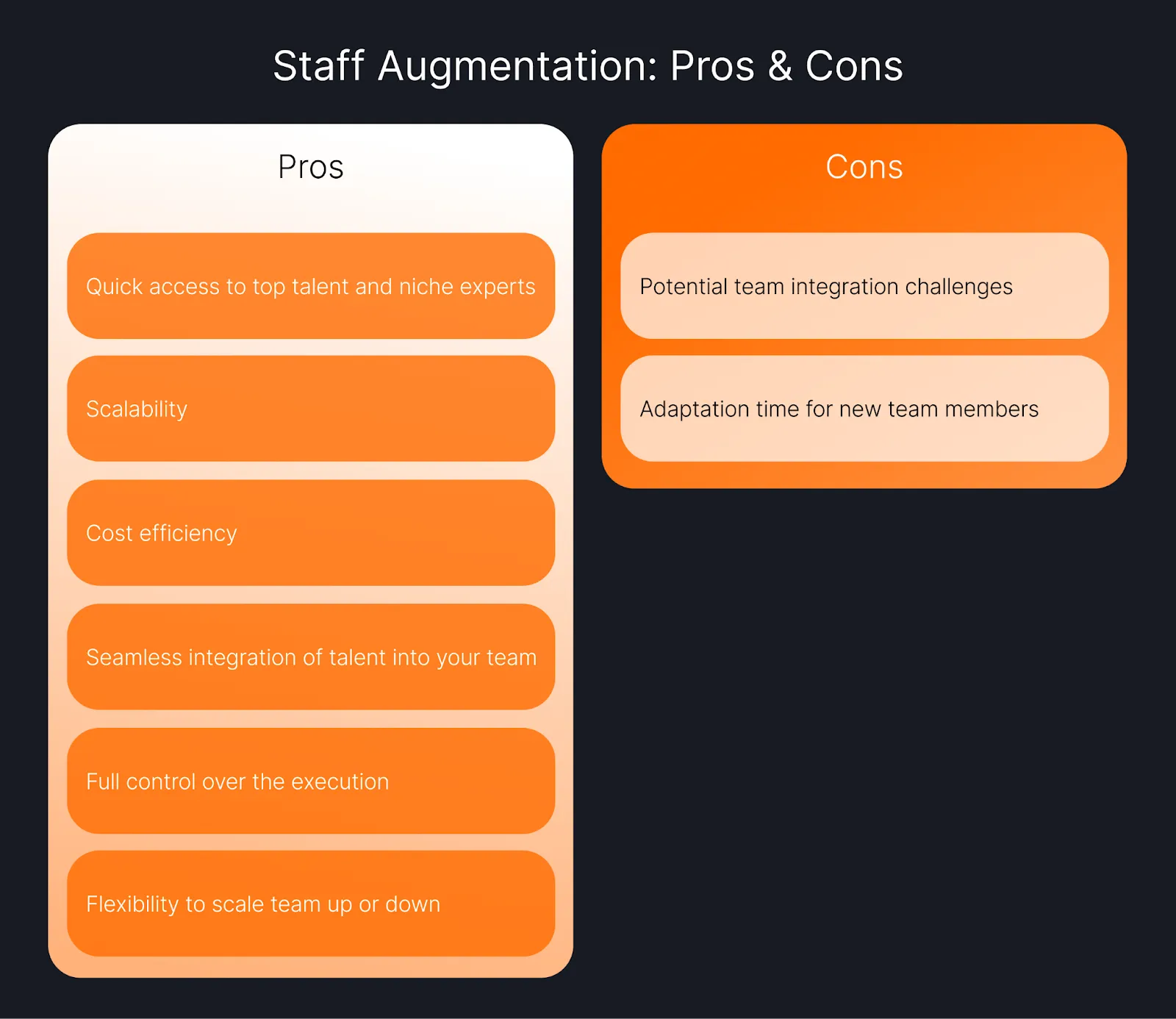
Advantages of Staff Augmentation
When you augment your staff, the expertise stays within your company. Unlike outsourcing, where an external team takes over a project, professionals brought in through staffing augmentation become part of your existing structure. This means your core team stays intact, and you bring in external talent for specialized tasks.
Another advantage of staff augmentation is role-specific flexibility. If you need niche expertise, staff augmentation allows you to be selective in the developers you bring on board while keeping full project control. This allows you to bring in niche experts who align with your project’s needs, whether it’s a specialist in a rare programming language or someone with deep experience in your domain.
-> Potential Challenges and How to Overcome Them
While staff augmentation offers flexibility and control, it’s not without its challenges. Here are two common obstacles and ways to address them effectively.
/**/ Integration with the Existing Team
Bringing in external specialists can sometimes disrupt team dynamics, leading to communication gaps or workflow mismatches.
How to Overcome It
🟧 Set clear expectations from the start regarding roles and responsibilities.
🟧 Use collaboration tools like Slack, Jira, or Asana to ensure smooth communication.
🟧 Encourage open feedback and team bonding to create a sense of belonging.
🟧 Partner with an experienced staffing augmentation company that can ensure smooth integration through well-developed and time-tested approaches.
/**/ Knowledge Transfer and Productivity Delays
Even the most skilled geniuses need time to get up to speed with your company’s workflows, tech stack, and expectations.
How to Overcome It:
🟧 Create structured onboarding materials, including documentation and recorded walkthroughs.
🟧 Assign a mentor or point of contact to speed up knowledge transfer.
🟧 Encourage open feedback so augmented staff can quickly adapt and ask questions.
🟧 Set the goal for new engineers to be contributing code by the end of their first week. A fast start makes for strong momentum.
The Difference Between Inhouse and Augmented Talent
Building an inhouse team gives you full-time employees who are deeply embedded in your company’s culture and processes. However, hiring full-time staff requires significant time and investment in recruitment, onboarding, and employee benefits.
The most distinctive features between inhouse teams and augmented staff are:
Time to hire
Full-time recruitment can take months, while staff augmentation provides specialists in weeks.
Cost structure
Inhouse hiring includes salaries, benefits, and office space, while augmentation is a pay-as-you-go model.
Scalability & Flexibility
Inhouse teams are fixed in size, making it harder to scale up or down, while staff augmentation allows you to expand or reduce your team based on project needs.
Project-Based vs Long-Term
Inhouse hiring is best for core, ongoing business functions, while staff augmentation is ideal for scaling initiatives and urgent deadlines.
Pros and Cons of Outsourcing
Outsourcing helps businesses delegate tasks, speed up development, and reduce operational burdens. It’s a smart way to get things done if you lack an in-house team, or don’t want to risk stretching them too thin. Still, like any business model, it has its ups and downs.
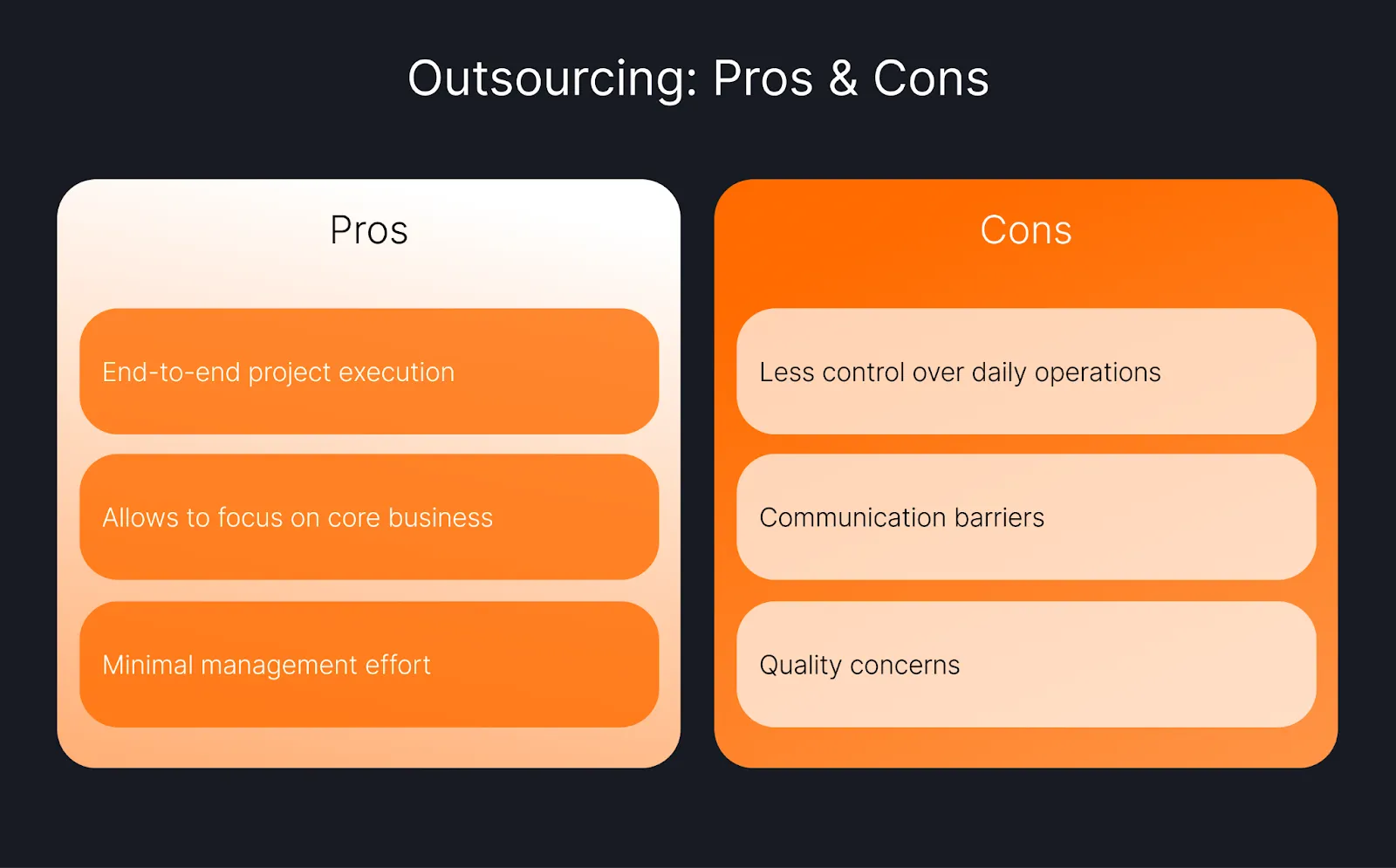
Benefits of Outsourcing for Businesses
> End-to-end project execution: A dedicated team handles everything, from planning to delivery.
> Allows you to focus on core business: Since the outsource team doesn’t require daily team involvement, your internal team can concentrate on strategic goals.
> Minimal management effort: Since the outsourced team works independently, there’s no need for onboarding, just clear terms and deadlines.
Challenges of Outsourcing and How to Mitigate Risks
While outsourcing is efficient, it requires careful planning to avoid common pitfalls.
⬛️ Less control over daily operations: Since the vendor manages the team, you might have limited oversight.
Solution: Set clear expectations, use project tracking tools, and schedule regular check-ins.
⬛️ Communication barriers: Time zones and language differences can slow things down.
Solution: Work with external teams who have experience in your market and establish clear communication guidelines.
⬛️ Quality concerns: Deliverables might not always meet expectations.
Solution: Start with a small project or pilot phase before committing to a long-term contract.
Comparing Outsourced with Dedicated Offshore Teams
Outsourcing is often seen as the go-to solution for handling projects outside a company’s core expertise. While it can work well for short-term, well-defined tasks, it comes with trade-offs – less control, rigid contracts, and potential misalignment with your internal team.
For companies needing long-term expertise or ongoing project support, staff augmentation offers a more flexible alternative. Instead of handing off an entire project, businesses can scale their inhouse teams with dedicated offshore specialists, ensuring smoother collaboration, better integration, and full project oversight.
While outsourced and offshore teams both provide external expertise, they operate differently.
Management and integration
Outsourcing provides a fully managed team that works independently, and receives little input from you or your staff. In contrast, offshore teams function as an extension of your business, integrating with your workflows after minimal onboarding.
Flexibility
Outsourcing is generally less flexible, as changes often require contract renegotiations. Dedicated offshore teams offer higher flexibility, allowing you to scale up or down based on project needs.
Control
An outsourced team is fully managed by the third party, including in their deliverables and day-to-day tasks. Dedicated offshore teams, in contrast, give you more direct oversight but leave much of the administrative work in the hands of your talent solutions partner.
Cost Structure
Outsourcing often follows fixed-price contracts aimed at cost savings, but may lack transparency due to hidden fees. Dedicated offshore teams operate on a pay-as-you-go model, balancing cost-effectiveness with high quality and accountability.
Long-term vs short-term
Outsourcing is ideal for project-based, short-term tasks that aren't central to your core mission. Offshore teams are better suited for continuous development and mission-critical projects where maintaining control is essential.
Which One Will Bring More Value to the Table for You?
Companies looking for development services often choose between staff augmentation and outsourcing based on their need for control and flexibility.
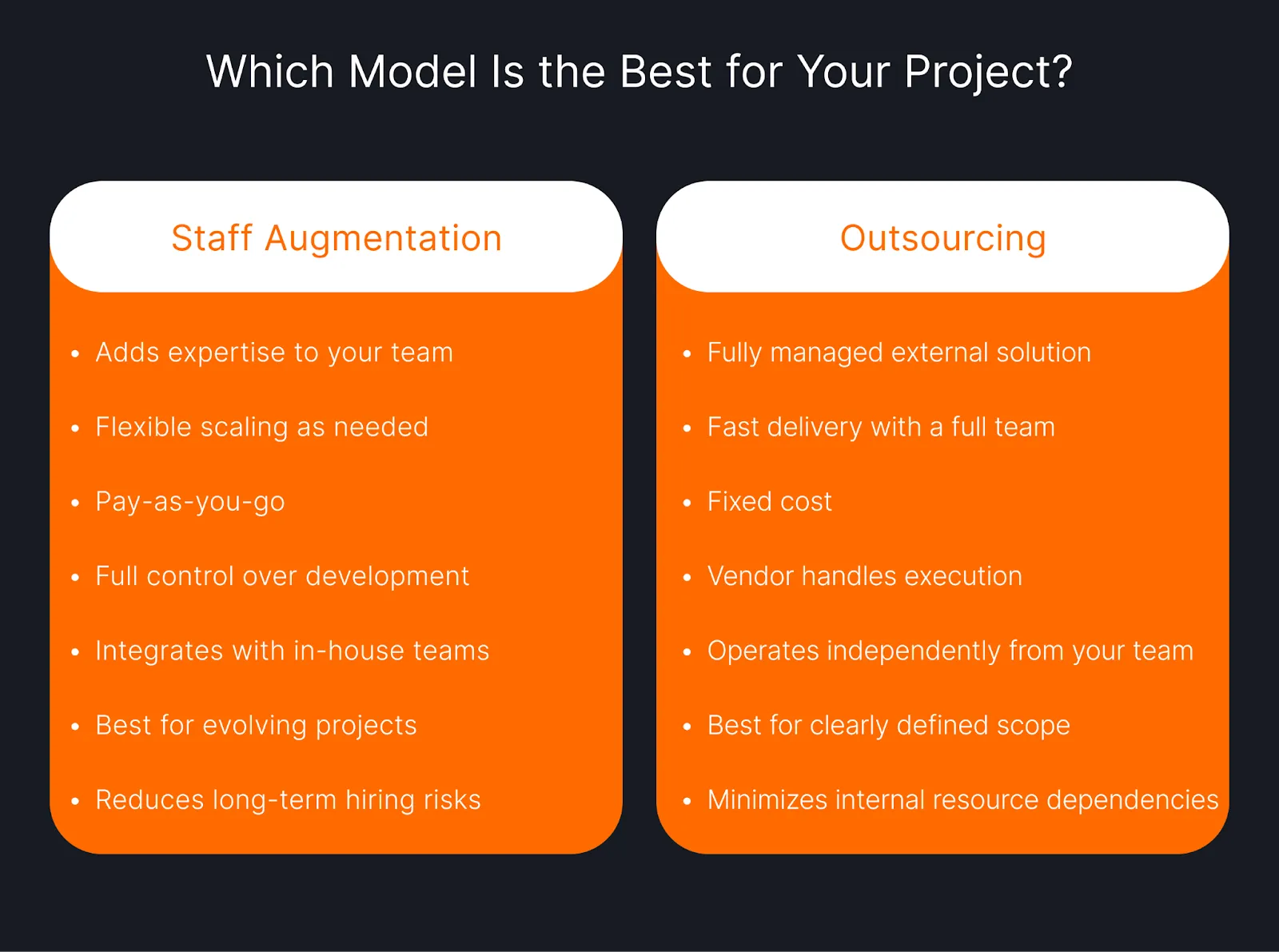
Factors to Consider: Project Scope, Timeline, and Budget
Project Scope
If you need specific expertise within your existing team for core operations, staff augmentation is an ideal solution. If you need a full, independently managed solution for a project that’s outside of core business, outsourcing is the way to go.
Timeline
Tight deadline? Outsourcing can speed things up since vendors provide complete teams. Need flexibility? Staff augmentation lets you scale resources as needed.
Budget
Staff augmentation is often more cost-effective for fluctuating needs, allowing you to pay as you go while retaining control over the team. However, it does require internal management of resources. In contrast, outsourcing typically offers a fixed cost structure, reducing administrative overhead and providing more predictable budgeting for larger or standalone projects.
Matching Business Needs with the Right Model
If you’re unsure which model to choose, ask yourself which conditions best describe your situation:
🟧 If you want to retain control over development → Go for staff augmentation.
⬛️ If you need a fully managed service → Choose to outsource.
🟧 If your project requires ongoing adjustments → Staff augmentation allows flexibility.
⬛️ If you need a turnkey software development solution → Outsourcing gets it done.
Case Studies: When to Opt for Staff Augmentation vs Outsourcing
The choice between staff augmentation vs IT outsourcing comes down to whether a business wants direct oversight of external talent or a vendor-managed solution. Staff augmentation is best when you need to expand your team with specific expertise while maintaining control. Outsourcing is ideal for fully managed projects where you want an external provider to take the lead.
Let us show a few illustrative examples of how each model is used.
Case 1: A SaaS company scaling the full-stack team
A growing SaaS company has an inhouse development team but needs additional full-stack developers to accelerate a new feature release. Hiring full-time employees would take months, and they don’t want to overextend their internal team.
Staff augmentation allows them to quickly onboard skilled developers who integrate with their existing team and workflows.
Case 2: A startup launching a mobile app
A non-technical startup has an idea for a mobile app but lacks an internal engineering team. They need end-to-end development – from UI/UX design and coding to testing and deployment – but don't have the expertise or resources to build it inhouse.
By outsourcing the project to an offshore software development provider, they get a full-service team that handles everything from planning to launch. This allows the startup to focus on business strategy while reducing time to market.
Case 3: A fintech firm needing special expertise
A fintech company wants to enhance its platform with a new AI-powered fraud detection system. The feature is complex, requiring specialized expertise in machine learning and cybersecurity. While they have an internal team, they need additional resources with deep domain knowledge to develop and integrate the feature seamlessly.
Instead of hiring internal specialists, they bring in a dedicated development team through staff augmentation. These external experts collaborate directly with the inhouse team, ensuring a secure, well-integrated solution.
Case 4: Cloud services provider looking for infrastructure support
A cloud solutions company offers enterprise clients high-availability hosting services. To meet customer SLAs, they need round-the-clock monitoring, troubleshooting, and maintenance. Managing a 24/7 inhouse team would be expensive and operationally complex.
By outsourcing infrastructure support, they ensure continuous system monitoring and quick issue resolution without the burden of hiring, training, and managing shifts internally. The outsourcing provider guarantees service reliability while the company focuses on core innovations. However, if their goal were to provide long-term IT support and maintenance, managed services might have been a better fit.
Staff Augmentation vs Outsourcing: Final Considerations
Both staff augmentation and outsourcing are powerful strategies for growing your core business and delivering projects efficiently. The right choice depends on your needs – whether you want to expand your team with specific skills or delegate an entire function to someone else.
Key Takeaways:
🟧 Staff augmentation works best when you need extra hands but want to keep control over the project. It’s flexible, cost-effective, and integrates seamlessly into your team.
⬛️ Outsourcing is ideal when you need a fully managed service. It reduces administrative burdens, offers generally predictable costs, and speeds up execution for large-scale projects that are outside the scope of the main business.
🟧 Staff augmentation follows a pay-as-you-go model, while outsourcing typically involves fixed project pricing or retainer agreements.
⬛️ The choice depends on your business needs – staff augmentation supports inhouse teams, while outsourcing delivers complete solutions.
How to Get Started with Your Chosen Model
> For staff augmentation, start by analyzing the specific skills required for the project. Next, find a reliable partner with a proven track record in sourcing top talent. Once you’ve selected the right partner, integrate specialists into your workflow with clear onboarding and management.
> For outsourcing, define your project scope, research vendors, and establish clear expectations to ensure smooth collaboration and high-quality results.
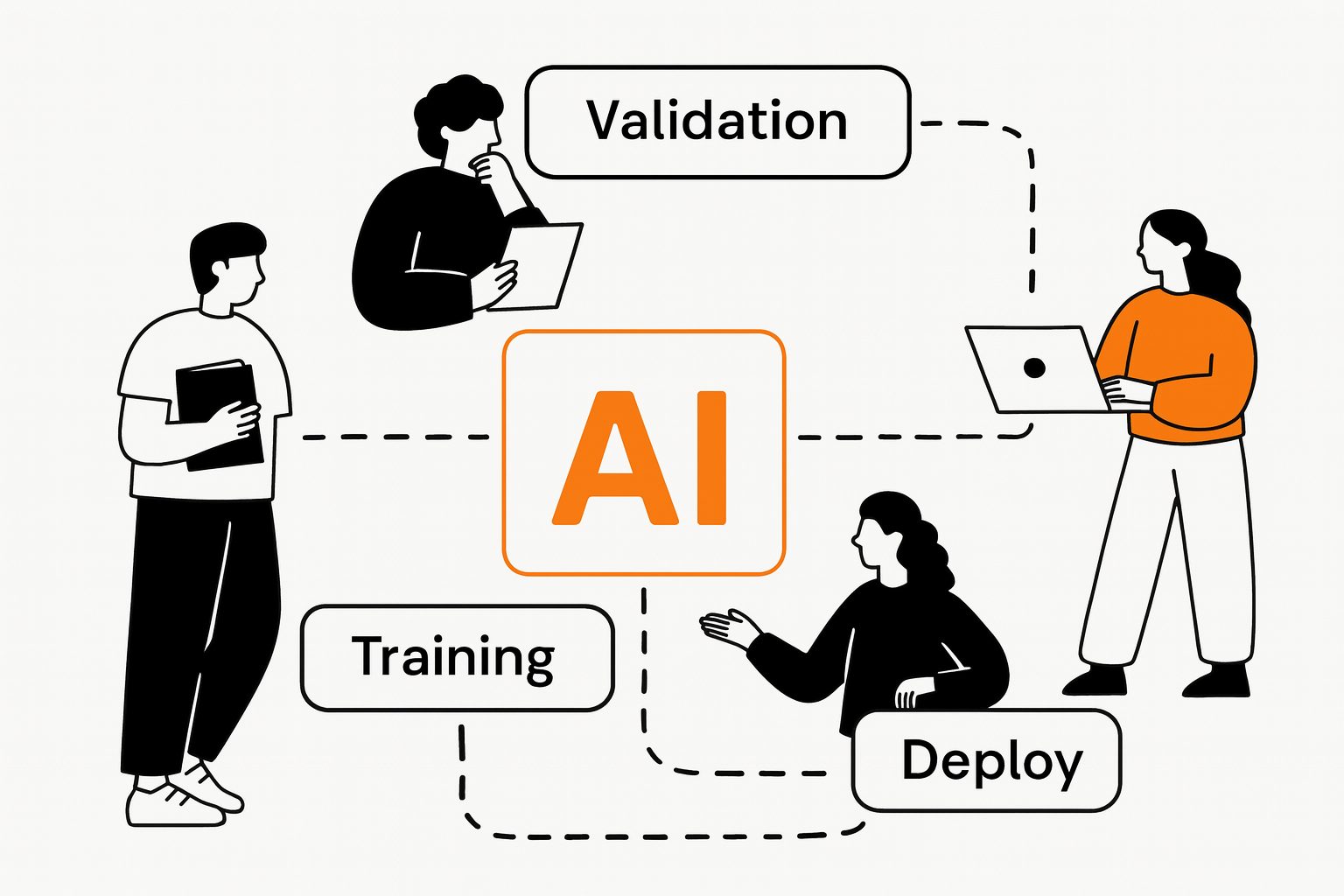
Building Successful AI-Enabled Technology Teams - A Strategic Framework for the Modern Enterprise
Discover how to build successful AI-enabled teams with proven frameworks, AI developers, and talent management strategies for modern software development.

Genius Match Strengthens Leadership Team with Industry Veterans Helen Prashchur and Elizabeth Jenkins
Genius Match announced the appointment of two seasoned sales executives to drive North American expansion.

The AI-Driven Evolution of Software Development: Why Global Talent and Human Expertise Matter More Than Ever
The software development landscape has undergone a seismic shift. AI assistants now write code, automate complex tasks, and streamline development workflows in ways that seemed impossible just a few years ago. While this revolution has transformed how we build software, it has also created new challenges and misconceptions that are reshaping the entire industry.